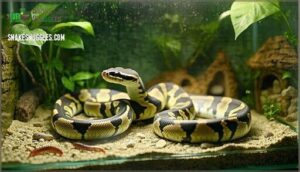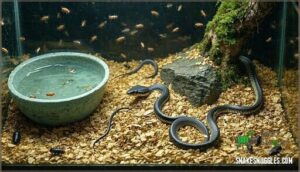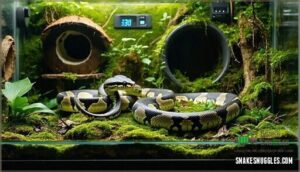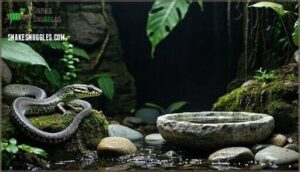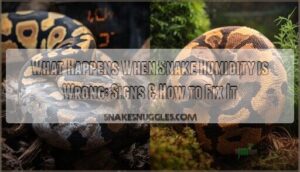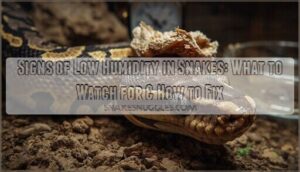This site is supported by our readers. We may earn a commission, at no cost to you, if you purchase through links.
 Your ball python stares at the perfectly thawed mouse in front of it, unmoved. You’ve checked the temperature, positioned it just right, even tried the "prey dance" with tongs—but your snake refuses to eat frozen rodents.
Your ball python stares at the perfectly thawed mouse in front of it, unmoved. You’ve checked the temperature, positioned it just right, even tried the "prey dance" with tongs—but your snake refuses to eat frozen rodents.
This feeding standoff isn’t uncommon, and it doesn’t mean your snake is being stubborn or sick. Most refusals stem from presentation issues, stress responses, or simple unfamiliarity with pre-killed prey. Understanding why snakes reject frozen food—and how their natural hunting instincts influence feeding behavior—gives you practical strategies to encourage consistent feeding and maintain your snake’s health.
Table Of Contents
- Key Takeaways
- Why Snakes Refuse Frozen Rodents
- Reasons Snakes Won’t Eat Frozen Mice
- Identifying Stress in Snakes
- Common Illnesses Affecting Snakes
- Addressing Parasite Infestations
- Maintaining Proper Husbandry for Snakes
- Seasonal Fasts and Breeding Complications
- Getting Picky Snakes to Eat
- Tips for Feeding Picky Snakes
- Encouraging Snakes to Eat
- Frequently Asked Questions (FAQs)
- Do snakes eat frozen rodents?
- How do you get a snake to eat a frozen mouse?
- Why do snakes eat frozen prey?
- Are Frozen rodents safe to eat?
- Do snakes eat pre-killed food?
- Do snakes eat live rodents?
- Why is my snake not eating frozen mice?
- Can you refreeze a mouse if snake doesn’t eat it?
- How to thaw frozen mice for snakes?
- Can snakes get sick from frozen mice?
- Conclusion
Key Takeaways
- Most feeding refusals stem from fixable presentation issues—improper thawing temperature, lack of movement simulation, or insufficient scent—rather than stubbornness or illness, so adjusting how you offer frozen prey often resolves the problem.
- Stress from environmental factors like incorrect temperature gradients, inadequate hiding spots, or excessive handling directly suppresses appetite, making proper husbandry essential before troubleshooting feeding techniques.
- Seasonal fasts during breeding cycles and brumation periods are natural metabolic adjustments where snakes refuse food due to hormonal changes, not health problems, so monitoring weight without forcing meals is appropriate.
- Gradual transition methods—scenting frozen prey with familiar odors, warming to body temperature, using tong movement to mimic live prey, and feeding at night—tap into natural hunting instincts and successfully convert most snakes from live to frozen rodents.
Why Snakes Refuse Frozen Rodents
If your snake turns its nose up at frozen rodents, you’re not alone. There are a few common reasons why this happens. Let’s look at what might be going on in your enclosure.
Lack of Familiarity With Prey
Familiarity plays a big role in a snake’s eating habits, and sometimes all it takes is a new scent or texture to throw off its appetite. Prey Imprinting and Early Exposure shape feeding behavior, so a snake used to live prey may balk at frozen rodents.
Try these techniques:
- Gradual Shift between prey types
- Scent Training with familiar odors
- Experimenting with Alternative Prey
- Observing previous feeding experiences
- Adjusting prey presentation
Inadequate Prey Presentation
Even if your snake recognizes the scent, how you offer the frozen rodent can make all the difference in whether it decides to eat. Try warming the prey item to mimic body temperature—snakes often respond better to well-thawed, warm prey. Use tongs for subtle movement, imitating live prey.
Adjust prey size to match your snake’s needs. Presentation timing matters, too; offer prey during their active hours. Scent enhancement, like braining, can further improve your snake feeding techniques.
Insufficient Scent or Movement
When your snake still turns up its nose after you’ve perfected your prey presentation, it often comes down to whether the rodent smells right or moves enough to spark its hunting instincts. Scent enhancement and movement imitation can bridge this gap. Try braining rodents, warming prey, or creating scent trails. These feeding techniques can help address snake feeding problems and feeding refusal rooted in snake behavior.
- Rub prey with soiled bedding
- Wiggle mice using tongs
- Warm rodents before offering
- Swipe prey with favorite scents
Reasons Snakes Won’t Eat Frozen Mice
Snakes can be picky about frozen mice, and the reasons aren’t always obvious. Sometimes, it’s about their environment or how the food is offered.
Let’s look at the main factors that might be causing your snake to turn down frozen prey.
Generative AI Ethics
Ever notice how some problems—like feeding a stubborn ball python or debating the ethics of generative AI—boil down to understanding what feels right and safe for everyone involved?
With snakes, feeding refusal can mirror concerns like AI bias or data privacy. Just as content ownership and algorithmic transparency matter in tech, your snake’s comfort and habitat security shape its willingness to accept prekilled prey.
Bias in Models
How often do you find that what seems fair in theory doesn’t always match up with real-world instincts—especially when your snake turns its nose up at frozen food? Data bias isn’t just for algorithms; your snake’s feeding behavior may favor live prey.
Bias detection and mitigation strategies, like scenting techniques, help address feeding problems and improve algorithmic fairness in your feeding routine.
Privacy Concerns
Isn’t it curious how the constant buzz of our connected lives might unsettle even the most reclusive creatures in your care? Surveillance risks and data collection aren’t just human worries—they echo in your snake’s environment. Owner responsibility means secure restraint, ethical considerations, and awareness of stress factors.
Feeding problems, including feeding refusal, often stem from subtle disruptions. When snakes refuse food, consider how your routines might contribute to their unease.
- Anxiety from unfamiliar routines
- Overexposure to movement or light
- Unintended stress from digital devices
- Ethical dilemmas in snake feeding problems
Impact on Employment
Job security might sound like a human concern, but regarding feeding your pet, confidence in your care routine is what keeps things running smoothly. If your snake refuses food, think of it as a skills gap—just like in pet store jobs or veterinary careers.
The breeding industry and conservation efforts all rely on reliable feeding routines and proper husbandry. Education roles in reptile care stress the importance of mastering temperature, humidity, and prey presentation.
Addressing feeding refusal means building your expertise to support your snake’s health.
2. Electric Vehicles
Feeding a snake frozen mice can feel a lot like learning to drive an electric car—there’s a bit of a learning curve, and both require patience as you figure out what makes things run smoothly. Just as EV Affordability and Battery Recycling shape car choices, your snake’s feeding problems hinge on cost, technique, and persistence. If your snake refuses food, think about these parallels:
- Charging Speeds: how quickly your snake gets used to new feeding techniques
- Energy Sources: the prey’s scent and freshness
- Autonomous Driving: hands-off feeding methods
- Leftover meals: meal waste management
Charging Infrastructure Development
Think of upgrading your snake’s feeding routine like building a better charging network—every improvement you make in their habitat helps power up their appetite and success with frozen prey. Charging accessibility translates to easy access to clean water and hiding spots. Grid capacity means keeping the enclosure at ideal warmth, supporting digestion and reducing feeding refusal. Standardized connectors and location planning are like consistent feeding schedules and strategic prey placement.
Integrating renewable solutions—such as varied enrichment—can transform reptile care, minimizing feeding problems and making snake care more predictable and rewarding for you.
Battery Technology Advancements
Ever notice how a well-charged battery keeps your devices running smoothly—your snake’s appetite works much the same way, thriving when you dial in just the right warmth and preparation for their frozen meals.
Effective thermal management boosts energy density and feeding speed, while poor material sourcing or technique can shorten appetite lifespan, causing feeding refusal and persistent feeding problems.
Environmental Impact Analysis
Just as battery performance can shape your snake’s appetite, the environment you create in their enclosure sets the stage for how eagerly they’ll accept frozen rodents.
Factors like Habitat Destruction, Prey Sourcing, Waste Disposal, and Energy Consumption all link back to wildlife conservation and ecology.
Your choices in wildlife feeding and enclosure care reflect broader conservation biology and wildlife management goals.
3. Remote Work Challenges
In much the same way that a well-designed workspace keeps you focused, the way you present frozen mice can make or break your snake’s interest at mealtime.
Isolation effects, home distractions, and blurred boundaries all impact snake feeding behavior. If feeding techniques lack variety or stimulation, your snake may refuse food—much like tech dependency can disrupt remote work collaboration.
Communication Barriers
If you’ve ever felt misunderstood during a video call, you’ll recognize how a snake might miss the message when frozen mice aren’t offered in a way it understands. Interpreting cues—like body language and environmental signals—is key for snake feeding.
Misunderstood signals or poor tactile communication often lead to feeding refusal. Adjust your feeding techniques; try simulating prey movement or warming the mouse. Snake behavior depends on clear, consistent communication during feeding.
Work-Life Balance
Finding harmony between your daily routine and downtime is a lot like coaxing a finicky snake to relax and accept its meal. Reduce snake stress and support snakes’ mental health by prioritizing husbandry and a balanced feeding schedule. Owners’ time management matters. Try these strategies:
- Set regular feeding times.
- Create a calm environment.
- Schedule breaks to prioritize snake care.
Productivity Tools
When your to-do list is as long as a boa, a few smart productivity tools can make managing snake care and feeding routines much less overwhelming. Integrate automation software and task management to track feeding strikes and monitor feeding behavior. Use time tracking for regular schedules, note-taking apps to log prey presentation, and communication platforms to share insights on snake feeding techniques and feeding refusal.
- Automation software for reminders
- Task management for feeding logs
- Time tracking for routines
- Note-taking apps for health records
- Communication platforms for advice
Identifying Stress in Snakes
Stress can make even a healthy snake refuse food. It often comes from changes in their environment or how they’re treated.
Here are some key factors that might be causing your snake stress.
Common Causes of Stress
Stress in snakes can sneak up like a shadow, often triggered by changes in their environment or routine that you mightn’t notice right away. Interaction frequency, enclosure size, substrate type, and the number of hiding spots all play a role.
Social isolation can also cause stress, leading snakes to refuse food and develop reptile health issues. Careful husbandry keeps these problems in check.
Captivity and Handling Stress
Trust is the foundation of a snake’s comfort in captivity, and it’s shaped by every interaction and adjustment you make to their environment. Interaction frequency matters—too much can trigger stress and feeding refusal.
Enclosure size and hiding spots are essential for acclimation. Watch for overinteraction signs, and always prioritize animal welfare in your snake care to minimize stress-related issues.
Habitat and Climate Stress
Imagine trying to eat dinner in a room that’s too hot, too cold, or just plain uncomfortable—your snake feels the same way when its habitat isn’t just right. Snake care hinges on proper reptile husbandry, so monitor these essentials:
- Temperature gradients for healthy reptile behavior.
- Humidity control for shedding and digestion.
- Enclosure size for natural movement.
- Lighting needs and substrate choice for comfort.
Small changes in enclosure temperatures can ease stress and encourage feeding.
Common Illnesses Affecting Snakes
When a snake stops eating, health issues are often to blame. Some illnesses can go unnoticed until feeding problems show up.
Here are a few common conditions that might affect your snake’s appetite.
Respiratory Infections and Tumors
Ever noticed your snake wheezing or breathing with its mouth open? These clinical signs often point to respiratory infections—common, especially in pythons, and linked to high mortality rates. A key factor is poor snake husbandry, which can lead to respiratory disease.
Tumor prevalence is less obvious but just as serious, with many snakes refusing food due to underlying illness. Infection diagnosis and prompt veterinary care are essential. Treatment options exist, but early intervention remains your best bet for maintaining snake health.
Internal and External Injuries
Did you know trauma causes in snakes range from vehicle accidents to animal attacks? Injury prevention starts with a secure enclosure and careful interaction. Internal injuries, like envenomation effects, often require a vet. External wounds—cuts or bites—need careful cleaning. Watch for these injury patterns:
- Internal trauma
- External cuts
- Bite wounds
- Stress-related health issues
Fatal snakebites are more common in dogs, but horses seldom die as a direct result of snakebite. Clinical outcomes depend on prompt care.
Addressing Parasite Infestations
Parasite infestations can sneak up on even the most carefully kept snakes. The right enclosure setup plays a big role in preventing these problems.
Let’s look at some options that help keep your snake safe and healthy.
Communal Enclosures and Parasites
How often do you check for parasite transmission risks in your communal enclosure? Good hygiene is critical. Overcrowding and poor cleaning let parasites thrive, threatening snake health and even exposing you to zoonotic parasite risks. Preventative anthelmintics and screening new additions are essential husbandry steps. Here’s a quick breakdown:
| Risk Factor | Solution |
|---|---|
| Overcrowding | Expand enclosure size |
| Poor sanitation | Regular deep cleaning |
| Unscreened newcomers | Fecal parasite testing |
| No anthelmintics | Scheduled treatments |
Snake Stress and Immune Systems
Just like overcrowding and poor cleaning can let parasites take hold, stress quietly chips away at your snake’s immune defenses and leaves it more vulnerable. Stress impact can show up in subtle ways, from immune suppression to poor appetite. Environmental stressors and frequent interaction both play a role.
For better reptile health and wellness, focus on stress reduction. Consider these practical steps:
- Limit unnecessary interaction
- Maintain consistent enclosure conditions
- Provide secure hiding spots
- Monitor for animal health issues
- Address changes in behavior quickly
Maintaining Proper Husbandry for Snakes
Getting your snake’s home environment right makes a big difference in its appetite and overall health. The right setup helps reduce stress and fosters proper feeding.
Here are some enclosure options for your consideration.
Habitat and Climate Conditions
Behind every healthy snake, there’s a setup that gets the basics—like temperature and humidity—just right from the start. A proper snake habitat isn’t just about a box and a heat bulb; you need thoughtful temperature gradients, reliable humidity control, and adequate enclosure size to reduce stress.
Don’t overlook substrate choice or lighting needs, either. When you prioritize these reptile husbandry fundamentals, you’re setting your snake up for a long, comfortable life.
Humidity Levels and Feeding
Once your snake’s home is dialed in, setting up the right humidity can make all the difference at mealtime. This impacts shedding problems, and it also aids respiratory health and hydration levels—essential for snakes prone to refuse food. Achieve success with:
- Thoughtful enclosure design
- Moisture-rich substrate
- Species-specific humidity
- Adjustments during shedding phases
Seasonal Fasts and Breeding Complications
When your snake refuses food during certain times of year or after breeding, it’s often linked to natural cycles. These seasonal fasts and breeding complications can affect appetite and behavior.
Let’s look at some enclosure options that can help support your snake during these periods.
Reproductive Fasts and Gestation
When your ball python or other snake refuses food during gestation, it’s not cause for panic—it’s a natural metabolic adjustment. Hormonal influence and physical changes mean appetite drops as eggs develop. Gestation length and species variation play big roles here.
Prioritizing proper husbandry and nutrition before breeding makes certain your snake copes well with stress and environmental factors while fasting.
Breeding and Seasonal Fasts
Although the Breeding Season brings anticipation, you might notice your ball python or other snake refuse food, especially frozen rodents. During Reproductive Cycles, hormonal changes shift priorities from eating to mating or Egg Laying. Seasonal changes, like cooler temperatures in the Brumation Period, can also trigger feeding refusal, as snakes conserve Energy Reserves for reproduction. You’ll see these behaviors most often when females are carrying eggs or males are actively seeking mates. To support your snake during these phases, adjust their care and monitor weight closely. Here’s what commonly drives feeding refusal:
- Hormonal distraction during mating.
- Egg development and laying.
- Shifts in nutritional requirements.
- Cooler seasonal temperatures.
Getting Picky Snakes to Eat
If your snake turns up its nose at frozen rodents, you’re not alone. There are a few tricks that can help even the pickiest eaters.
Let’s look at some enclosure options that can make feeding time easier.
Reducing Stress and Stimulating Appetite
If your snake seems uninterested in food, sometimes a calmer environment and a bit of clever enrichment can make all the difference. For instance, adding Enclosure Enrichment or reducing interaction can ease stress. Try Scent Enhancement for frozen prey, or switch to Nocturnal Feeding. Here’s a quick guide:
| Method | Effect |
|---|---|
| Enclosure Enrichment | Calms behavior |
| Scent Enhancement | Stimulates appetite |
| Nocturnal Feeding | Matches instincts |
| Gradual Shift | Reduces refusal |
Exploring Prey Presentation
Sometimes, the way you offer a meal matters just as much as what’s on the menu. Prey presentation can make or break your snake’s interest in frozen rodents. Try warming techniques, or use feeding forceps to gently animate the prey item. Scent boosting—like rubbing the mouse with gerbil bedding—can trigger feeding behavior. Presentation timing also matters; snakes often respond better at night. Experiment with prey size, too.
Here are three practical tips:
- Warm prey before offering.
- Use tong feeding for movement.
- Boost scent to boost appetite.
Small changes can yield surprising results.
Tips for Feeding Picky Snakes
If your snake turns up its nose at frozen rodents, you’re not alone. There are practical ways to make feeding time more appealing.
Let’s look at some enclosure options that can help encourage picky eaters.
Stimulating Appetite With Movement and Shelter
Think of your snake’s enclosure as a stage—when you set the scene with movement and shelter, you’re inviting natural hunting instincts to take center spotlight. Try these strategies:
- Add hiding spots to reduce stress and boost feeding behavior.
- Rearrange for a secure enclosure that mimics nature.
- Wiggle prey to simulate movement and encourage a feeding strike.
- Offer food at night, matching snake feeding behavior.
Encouraging Natural Feeding Instincts
Ever noticed how a little creativity at feeding time can turn your reluctant snake into a keen hunter? Mimicking movement—like “dancing” a thawed mouse—often triggers a feeding strike, tapping into natural animal behavior. Scent enhancement, such as rubbing prey with used substrate, can encourage feeding behavior by making frozen rodents more appealing.
For instance, a well-designed hunting environment, with varied prey and thoughtful prey presentation, helps your snake feel secure and curious. Establishing a consistent feeding schedule also builds routine, reducing anxiety. If live feeding isn’t safe or practical, focus on strategies that replicate the experience.
Here’s a quick guide:
| Strategy | Benefit |
|---|---|
| Mimicking movement | Triggers feeding strike |
| Scent enhancement | Reduces anxiety |
| Varied prey | Stimulates appetite |
| Hunting environment | Promotes comfort |
Encouraging Snakes to Eat
Now that you’ve tried a few tricks to tempt your picky eater, let’s talk about some simple ways to spark their interest in frozen food. A snake’s feeding behavior often hinges on how you present the prey.
Scent enhancement—rubbing thawed mice with gerbil bedding—can make them more appealing. Tong feeding lets you mimic movement, catching their attention. Night feeding works well because snakes are naturally more active after dark.
If your snake refuses food, a gradual shift is key; start by mixing live and frozen prey, slowly shifting to only frozen. Sometimes, covering the enclosure provides privacy and reduces stress.
Each method helps create a routine that encourages your snake to feed with confidence.
- Scent enhancement
- Tong feeding
- Night feeding
- Gradual shift
Frequently Asked Questions (FAQs)
Do snakes eat frozen rodents?
Many captive snakes accept frozen rodents without issue, particularly when proper thawing and presentation techniques are used.
Wild-caught individuals may initially resist frozen prey due to unfamiliarity, but most adapt with patience and correct scenting methods that boost prey appeal.
How do you get a snake to eat a frozen mouse?
Thaw frozen mice completely and warm them to body temperature using warm water. Use feeding forceps to create movement during prey presentation, which triggers your snake’s hunting instincts.
Scent enhancement through braining prey or rubbing it with bedding material increases appeal.
Provide a secure feeding environment and attempt gradual adjustment techniques at night.
Why do snakes eat frozen prey?
Frozen rodents offer prey safety by eliminating bites and scratches from live animals. They’re cost-effective, convenient to store, and maintain nutritional value when properly stored.
Ethical considerations also favor this humane approach to reptile nutrition and snake feeding behavior.
Are Frozen rodents safe to eat?
When treated correctly, frozen rodents are among the safest prey items for reptile nutrition. Proper thawing best practices and storage guidelines prevent contamination risks, while careful treatment eliminates parasites common in live prey.
This supports reptile health and wellness through consistent rodent nutritional value.
Do snakes eat pre-killed food?
Most captive snakes readily accept pre-killed prey, which eliminates risks from live prey bites or scratches.
Proper thawing and warming improves scent, making frozen-thawed prey appealing while maintaining nutritional value and promoting safe feeding behavior.
Do snakes eat live rodents?
Yes, snakes eat live rodents in the wild and sometimes in captivity. However, live feeding ethics remain controversial.
Prey injury risk to your snake is real, as cornered rodents can bite and cause serious harm. Close supervision during feeding is essential.
Why is my snake not eating frozen mice?
Your snake might be treating that frozen mouse like yesterday’s news. Stress, improper thawing methods, or heating issues can dampen your snake’s interest in prey items.
Ball Python Care and Feeding often involves adjusting prey size, reducing interaction frequency, and making certain the frozen mice reach the right temperature to trigger natural snake feeding behavior and overcome feeding refusal.
Can you refreeze a mouse if snake doesn’t eat it?
You shouldn’t refreeze thawed prey items. Bacterial growth accelerates once frozen mice reach room temperature, creating food safety risks for your snake.
Refreezing also causes nutritional loss, degrading the prey’s value as a meal.
How to thaw frozen mice for snakes?
You’ll need about an hour to properly thaw frozen mice for your snake. Submerge prey items in cold water for 30-60 minutes, then warm them in hot (not boiling) water before feeding. This method preserves nutritional impact while guaranteeing safe temperature control for heating prey without cooking tissue.
Can snakes get sick from frozen mice?
Properly treated frozen mice won’t make your snake sick. You need to thaw them completely and make sure they reach room temperature before feeding to prevent digestive complications.
Frozen rodents actually reduce risks—bacterial contamination from improper prey storage poses more danger than the freezing process itself. Unlike live prey, frozen mice eliminate parasite transmission and injury risks.
If rodent quality is poor or thawing methods are rushed, nutritional deficiencies or bacterial growth can occur. Proper storage and care protect your snake’s reptile health and wellness.
Conclusion
Your snake’s refusal to eat frozen rodents often resolves with patience and adjustments to feeding technique. Success comes when you align presentation with natural hunting triggers—proper temperature, realistic movement, and adequate scent.
Monitor your snake’s body condition and behavior patterns, but don’t panic over occasional meal skips. Most healthy snakes adapt to frozen prey once stress factors diminish and presentation improves.
When standard methods fail, consult a reptile veterinarian to rule out underlying health issues affecting appetite and feeding response.
- https://books.google.com/books?hl=en&lr=&id=INMPBgAAQBAJ&oi=fnd&pg=PA3&dq=ball+python+eating&ots=QdLOGNh-X2&sig=e4ZWJc8OnrQuTAZgJsTQ42MkLMI
- http://www.anapsid.org/ballfeed.html
- https://jkrballstreetjournal.com/2014/02/12/the-psychology-of-problem-feeders-get-your-ball-python-eating-again/
- https://exoticskeeper.com/blog/understanding-respiratory-problems-in-snakes/
- https://www.frontiersin.org/journals/veterinary-science/articles/10.3389/fvets.2019.00338/full


